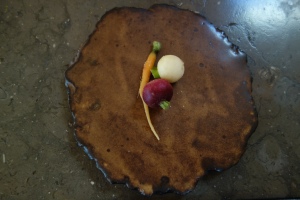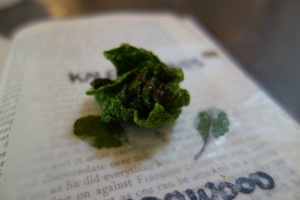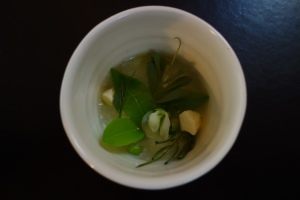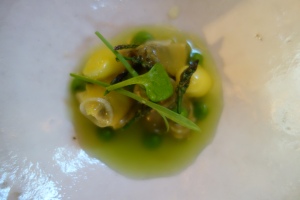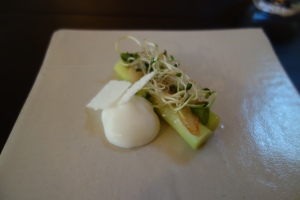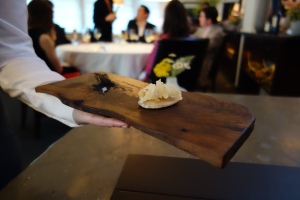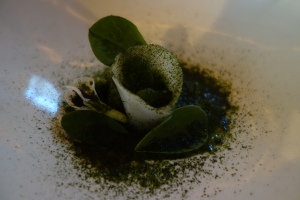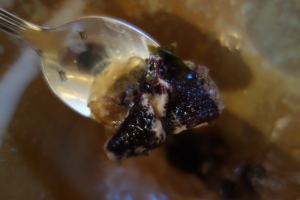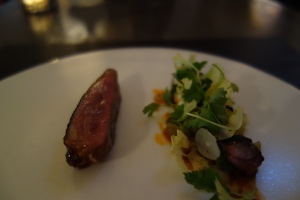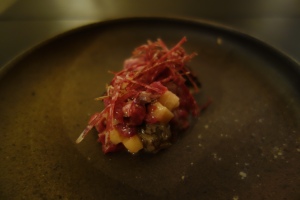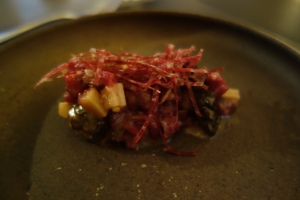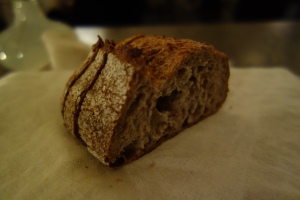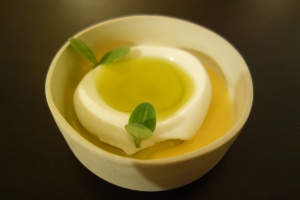- Address: 178 Townsend St, San Francisco, CA 94107
- Phone: (415) 828-7990
- Price (after tax + tip, excl. drinks): $325
- Courses: (14 main/19 total) 1 amuse / 12 savory / 2 dessert / 1 bread / 3 mignardises
- Price/Main Course: $23
- Rating: 20/20
- Value: 4/5
- Dining Time: 150 minutes
- Time/Course (total): 8 minutes
- Chef: Joshua Skenes
- In Own Words: “There are a number of principles that resonate throughout the menu: if I buy a piece of fish or meat, it has to be the best specimen possible of that product. It has to be the best I’ve had in my life. If it’s not, I need to keep looking for it. It’s the same with the cooking process. If I tasted something and it’s not at that level, we need to keep searching for it.” – http://eater.com/archives/2012/04/18/joshua-skenes-interview-part-one.php
- Style: Ingredients-driven
- Michelin Stars: 2
- Notable: #1 restaurant in the United States for OAD 2014.


PREAMBLE
There are three things above all to look for in a great restaurant. The first is the ingredients: how dedicated is the chef to getting the best produce possible to the table? How does the quality shine through? The second is the cooking style: what is the merit of each individual dish? Does the chef have a vision? What is the level of originality? How is the menu structured? The third is the service: is it a joy to step into the room? I only rate restaurants on the first two things, but I am also watchful for great service. I am glad to report that the service at Saison was top-notch. We felt right at home.
On the 3 above counts, Saison delivers. Rarely does the Triforce of ingredients, cooking, and service, come together in one package. But it does here.



COMPARING REACTIONS WITH GASTROMONDIALE
It was instructive on this San Francisco trip to contrast my reactions with the famous food critic, Vedat Milor (of Gastromondiale, and the late Gastroville blog with Hedone chef Mikael Jonsson), especially since we shared two touchpoints he has written about in detail (Saison & Manresa). Of the major critics, I would say that V Milor I have found who is the one closest to my taste so far. We share similar opinions about Per Se, EMP, Blue Hill at Stone Barns, and Alinea, as well as l’Arpege – so the first two nailed-on names on my San Francisco trip were Saison and Manresa, restaurants he believes are the two best in the Bay Area. It indeed ended up that out of the 5 high-end restaurants I visited this trip (in chronological order, Atelier Crenn, Saison, Benu, Manresa, Meadowood), Saison and Manresa were my two favorites.
On the face of it, Saison should absolutely be the kind of the restaurant that V Milor, a noted ingredients and barbecue fanatic, likes. (see his reviews of Asador Etxebarri) Chef Joshua Skenes is also an ingredients fanatic. (see “in own words” quote above) Yet he rates it 17.5/20 (for him, “a restaurant that offers outstanding food made with exceptional to outstanding ingredients but where there is room for improvement with respect to ingredient sourcing, executions of the preparations or where the originality or style is not clear.”). – Source
In ingredients-sourcing, Chef Skenes is certainly among the most diligent:
Recently, though, Mr. Skenes began to work with a Bay Area fishing captain who reels in all kinds of species, monkey eels and idiot fish, and delivers them live to the restaurant. “We’re going to try to wean ourselves off Japan, so we’re more representative of the Bay Area,” he said.
Subsidizing a boat to custom-catch fish for Saison is an expensive proposition. There is also the cost of the seaweed forager and the poultry ranchers who raise pigeons to Saison’s exact specifications. Mr. Skenes said that his ingredient costs are barely covered by the menu price, and that a cancellation can put the restaurant in the red. Thus, the fees for changing plans within 72 hours. – NYT
Since there is clearly no problem with ingredients sourcing, nor the execution of most preparations (he positively gushes about each of the dishes in his review, except the first (turnip custard) and eleventh (baby pigeon)), so I can only imagine that Mr Milor thinks the style lacking. This is where I disagree with him, for Saison to my mind has a very unique style amongst the American fine-dining restaurants: most if not all dishes have been touched by fire, intensifying their flavors. The 11th dish in my meal was grilled asparagus, poached in its juices and then grilled. It imparted the outside of the asparagus with a delightful char flavor that intensified the contrast with the juicy texture and asparagus tastes within. Or the 5th dish, a roasted abalone, that enhanced the meaty texture while ridding it of rubberiness, all the while working magic on its tastes. To my mind Saison is actually one of the few restaurants I have dined in anywhere, where the style is recognisable, and yet completely in service to the tastes of the dish. For example, a dinner the previous night at Atelier Crenn, featured a Duck Consomme to be drunk while eating a dish with Chocolate elements, an overplaying of Chef Dominique Crenn’s modernist whimsy which created a confusing-tasting dish. I detected no such excesses here. The visual presentation is also a delight, with textured glassware and expensive flatware. (the many-holed plate makes a reappearance from Brooklyn Fare).
CUTTING-EDGE STRATEGIES
I think, in a way, the 3 San Francisco restaurants I dined at (Atelier Crenn, Saison, Benu) represent 3 major strategies of differentiation in the culinary world today. That a lot of consumer money goes into dining experiences, is because there are dining experiences in the plural. The “foodie” trend, where more and more restaurants are seen as destination worthy, has demand factors (networks of information through Twitter, Facebook, RSS etc.), but also majorly depends on supply factors like sufficiently differentiated products (restaurant experiences) to attract money. A dinner at Alinea is completely different from a dinner at Eleven Madison Park, which is completely different from a dinner at l’Arpege, which is completely different from… . Speaking purely about my dining experiences in the Americas, there seems to be 3 major strategies that are considered cutting-edge.
A. For restaurants like Atelier Crenn; Alinea; atera, it is about the process. The dishes are process-driven, conceived using molecular techniques, and generally served with the aim of subverting the diner’s expectations. The catch-all term is molecular gastronomy. This tends to create particularly root-less restaurants. There is no reason why atera and Alinea, could not switch cities tomorrow without anyone blinking an eye. The process and science of creating these dishes are the intellectual capital of the infinitely mobile chefs. (The truly novel molecular dishes, like floating balloons in Alinea, or a cracked egg dessert at atera, are quite rare.)
B. For restaurants like Benu; Momofuku Ko, and other fusion restaurants like Maido in Peru, it is about introducing new types of tastes. It more commonly manifests as bold flavor combinations and Asian-fusion. In this case, diners expect to be educated with regard to a wider taste bank. The main difference I see between these restaurants and a restaurant like Borago in Chile is that the fusion restaurants are more-or-less rootless, taste without terroir. Nikkei, I believe, is a culinary concept that travels well outside of Peru, and Benu and Ko could also switch cities seamlessly (for many Asian-fusion restaurants I do tend to judge them more harshly, having grown up with these tastes, but I accept that they may be judged more novel and exciting by Western palates)
C. For restaurants like Saison, to a greater extent Manresa, and many of the foraged restaurants like Borago in Chile and Central in Peru, they put equal weight on the ingredients and the process. For the ingredients, it is about terroir, and reflecting a sense of place. Saison has a boat that catches seafood off the California coast specially for the restaurant, and Manresa’s produce reflects the excellence available from Love Apple Farms. Borago forages ingredients from 80km around Santiago. These restaurants rely on the integrity of their local ingredients, but also ally it to their own chosen process and philosophy. (Because great ingredients alone cannot make great dishes, chefs must have license to play with the tastes and textures of great ingredients to transmute them into great dishes). For Saison it is fire, Borago and Central: molecular techniques with plating ingenuity, for Manresa it is judicious use of modernist techniques with attention to complimentary tastes.
There are exceptions to this trichotomy: Eleven Madison Park, I think, is mainly about the theatricality, a non-food related reason. And certainly there must be other more subtle strategies, but at a broad stroke this is what I’ve seen.
THE FIRE
Really, truly exceptional ingredients are just step one. If you’re willing to pay the price, a lot of people can have access to that. The handling, the part afterwards, is very important. How do you care for something afterwards, to make sure that it’s in its most perfect state after you get it? You can get the best [ingredient] in the world, but if you don’t truly care for it, then it really doesn’t matter, if it goes bad because of handling. When we cook the food, we want to honor the fundamental and inherent flavor of those ingredients, so our food is a little more subtle, and more based on the natural expression and fundamental flavors of whatever it may be. That’s why we have our fire—the use of fire is the most genuine way to cook, in terms of flavor; the most genuine flavor you can get, or the most natural flavor you can get. And how to deepen those things. How do you really deepen or distill the furthest point in an ingredient’s flavor without adding so much to it?
Was it challenging to get permitting to have live fire in the restaurant? It was expensive?
What kind of hoops did you have to jump through? It’s always an issue, but we have such a talented kitchen designer that it wasn’t much of an issue for us in terms of those things. Tim Harrison was phenomenal. He’s someone that I’ll probably remodel the restaurant with 100 times throughout the course of the next 30 years.
– Source
Ingredients minimally cooked, or cooked in a perfunctory way, is nihilism. Nihilism because it reflects the belief that there is nothing more a chef can add besides the testimony of the ingredients. This is perhaps the source of the old East Coast joke about Californian cooks being good shoppers. How does Saison transform the ingredients?
Fire. A variety of fires, from high-intensity Japanese white charcoal to oak charcoal is used, and the element of fire is used to enhance individual elements in many dishes. The chaotic, high-intensity fire is one thing missing from most restaurants in the United States. My understanding is that fire-regulations have long prevented the primordial fire from penetrating urban areas, leaving it to barbecues in the South to harness it. (In a trip to the famous Salt Lick in Texas last year, we could smell the woodburning from a generous distance away as soon as we stepped out of the car). Even excepting fire-regulations for the flame, it is expensive, and space-intensive, to provide ventilation systems for the smoke. Saison, funded by Twitter billionaire Jack Dorsey and others from VC firm Benchmark Capital, is clearly well-funded. In a humongous space (called Saison 3.0 as it opened last year), a ventilation unit the size of a studio apartment hovered over the entire open kitchen space, preventing smoke and heat from reaching the dining room even though there were no partitions. A marvel of technology. Certainly Saison has many dishes involving the fire that will be hard to replicate in kitchens without the ventilation technology (at least in metropolitan areas).
In comparison to my visit earlier this month to Brooklyn Fare (which I rate as the best restaurant in New York), I noticed that there were no significant fire-based dishes. I may be wrong, but I did not notice any grills in the main kitchen area, only induction burners. I suspect the reason behind the lack of fire-based dishes was that the space is probably too small to accommodate both a ventilation unit to handle the smoke and an air-conditioning unit to handle the heat.
I think back to my visit last year to Singapore’s Burnt Ends: 850 degrees celsius, which created some rustic and delicious dishes, and cooked most of the dishes in a closed heating unit. There is definitely a demand for fire, witness the acclaim that Asador Etxebarri (which I hope to visit in June) has gotten from the shill-list San Pellegrino, and Burnt Ends has been a great (and packed) success in Singapore over the last year. I think the charcoal fire will become increasingly important in American cooking in the coming years.
FINAL THOUGHTS
From my own limited experience dining around the United States, I can confirm that Saison is performing well above what passes for 3-Michelin-star cooking in this country. To my mind, this is the best restaurant I’ve tried in the United States. There are no perfect restaurants. But there are restaurants which take perfectionism more seriously than most.
Rating: 20/20
Memory: Caviar, Abalone, Sea Urchin Toast, Trout, Black Cod, Parker House Rolls, Duck Liver Toffee, Rhubarb Jasmine Sorrel


 1. tea, herbs from our garden and their flora
1. tea, herbs from our garden and their flora
Meyer lemon and douglas fir tea, with herbs in garden left to steep in the tea. A good palate opener, reminiscent of a Chinese or Japanese meal to me, where the first opener is the choice of tea.


 2. white sturgeon caviar, sturgeon belly cured & smoked on kelp, gelèe of the grilled bones (4.75/5)
2. white sturgeon caviar, sturgeon belly cured & smoked on kelp, gelèe of the grilled bones (4.75/5)
White sturgeon caviar from California. This is on par with some of the best caviar I’ve tried anywhere, and I actually prefer the mouthfeel of this slightly firmer white sturgeon caviar to Osetra caviar, which I find “pops” its salinity in the mouth with less pressure.
The pleasure of caviar is when the roe “pop”s its saline yolky liquid in your mouth. I’ve always enjoyed caviar on the slightly firmer side. This to me was decadence.
The belly provided the fat; the gelee provided a umami meatiness to the dish, really highlighting the sturgeon’s caviar at its best.



 3. wild thistle, bouillon (4.5/5)
3. wild thistle, bouillon (4.5/5)
artichoke and Hokkaido scallop puree. Anchovy mayo at the bottom anchors a hollowed out artichoke, filled with scallop mousse made from Hokkaido scallops, and grilled in the fire together. Topped with an oxalis (AKA wood sorrel) flower

Number Three: Rum, Pandan, Fresh Lime, Young Coconut Syrup

 4a. (cru 1) coal kissed cherry blossom sea bream (5/5)
4a. (cru 1) coal kissed cherry blossom sea bream (5/5)
wrapped around monkfish liver. Fantastic piece of fish, firm yet tender, perfect.

4b. (cru 2) golden eye snapper warmed under some coals, bone vinegar (4.5/5)
with nori wasabi on top

 4c. (cru 3) pickled horse mackerel on toast (4.5/5)
4c. (cru 3) pickled horse mackerel on toast (4.5/5)
with last spring’s pickled ramps. A firm texture, as with most horse mackerel, the toast heated over coals
The series of crudites were of uniformly high quality, basically as successful as I can imagine this type of crudite-series dish being.

 5. abalone, roasted over the embers, sauce of the liver & capers (5/5)
5. abalone, roasted over the embers, sauce of the liver & capers (5/5)
incredible dish. an 8-10 year old monterrey bay abalone had the firm meatiness, but none of the rubberiness that can sometimes be unpleasant. Perfectly roasted with the taste of fire. It was topped with fresh nori (mamanori), and what really elevated it was the sauce made from its liver and capers. The sourness of capers was also reminiscent of a really good horseradish paste, a very bold flavor, that had complexity from added meatiness of abalone liver. Astounding sauce pairing.

6. sea urchin toast, river vegetable (5/5)
Fort Bragg sea urchin, about the size of my index finger, was the largest sea urchin I had ever seen. It was sweet and pure, I would say sweeter than even the Santa Barbara type. (I am actually fairly agnostic between Santa Barbara and Hokkaido uni – I would say the sweetness of SB uni is equally good as the more marine flavor of the Hokkaido variety).
the toast was long thin piece, toasted in yeast butter. fantastic.

 7. battle creek trout, smoked in the wood oven, sauce of the bones (4.5/5)
7. battle creek trout, smoked in the wood oven, sauce of the bones (4.5/5)
a melt in your mouth smoked trout was cured for 2 months under salt, and with an almondwood (sic?) pickled daikon.


8. white asparagus royale (4/5)
A solidified Royale sauce (liver, truffle, Madeira port) was mixed with an egg + kuzu custard
white asparagus and smoked pine-nut (blanched, smoked, dehydrated)

 9. black cod, poached in sea water, rangpur lime and yogurt (4.75/5)
9. black cod, poached in sea water, rangpur lime and yogurt (4.75/5)
a falling apart black cod (Half Moon Bay, CA), in two sauces. The first is coconut oil. The second is coconut milk + yoghurt + ginger + kaffir lime + galangal
plaintain chip on top
This was a great tribute to southeast Asian cooking (especially Thai green curry) The fish was expertly poached.
This dish made the Ulterior Epicure’s top of 2013 list as well. Great dish.
 10. [bread] parker house rolls (5/5)
10. [bread] parker house rolls (5/5)
Fluffy, hot, glazed in butter, and sprinkled with salt. The best parker house rolls I’ve ever had.

 11. asparagus, cooked in their juices and then grilled (4.5/5)
11. asparagus, cooked in their juices and then grilled (4.5/5)
The first asparagus of the season came in early February from Brentwood, CA. These were poached in their own juices. The grilling imparted the outside of the asparagus with a delightful char flavor that intensified the contrast with the juicy texture and asparagus tastes within.
egg yolk in circles of chive

 12. celeriac, poached in smoked water, some herbs from the garden (3.75/5)
12. celeriac, poached in smoked water, some herbs from the garden (3.75/5)
Hot sauce, sesame sauce, with a roasted chip of celeriac and roasted slices of celeriac underneath. The sweetness of underlying sauce (like sugar and hot sauce) was a bit one-dimensional for me.

 13. toffee, milk, bread & beer (5/5)
13. toffee, milk, bread & beer (5/5)
California instituted a foie gras ban some time ago, which makes it hard to get around it. Here “savory duck liver toffee” approximated that magical ingredient. It was topped with white chocolate, with a yeasty topping of milk, bread & bear. Surprisingly refreshing before the final main, it was also a prelude to dessert. Sui generis.


 14. wood pigeon, sunchoke & sunflower seed butter, coffee beans (4.5/5)
14. wood pigeon, sunchoke & sunflower seed butter, coffee beans (4.5/5)
dry aged pigeon for 30 days, its breast grilled, and with an intense funky dark jus. a quenelle of sunchoke+coffee+sunflower puree
morels with stuffed with boudin white sausage made from breast + gizzard + foie + chicken, with pigeon.
at 10 o’clock, pear and pear butter
pigeon cutting almost like a medium-hard cheese (cleanly and softly)


 15. rhubarb, jasmine, sorrel (4.75/5)
15. rhubarb, jasmine, sorrel (4.75/5)
Kumquat, shiso, two Bavarois (rhubarb at the bottom [pink], and jasmine on top [yellow]) with chamomile tastes.
A sorrel granite made with liquid nitrogen
At the very base, a white chocolate feuilletine
Very good.


 16. black walnut, soufflé and ice cream (4.5/5)
16. black walnut, soufflé and ice cream (4.5/5)
A good pairing of black walnut soufflé with maple flavors. Nuttiness with sweetness, Hot souffle cut by cold ice cream.


Buckwheat tea to end the meal
 17. Tartlets, meyer-lemon poppyseed and chocolate spearmint (4.5/5)
17. Tartlets, meyer-lemon poppyseed and chocolate spearmint (4.5/5)

18. Liquid Peanut Truffle (4.25/5)

19. Canele de Bordeaux, held under the coals, with a splash of orange blossom essence (4.75/5)

Earl Grey brioche to take home.





Tags: 2* Michelin, Joshua Skenes, Matthew Mako


























































































































































































































































































































